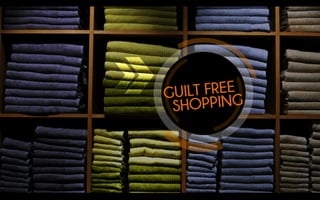
Guilt-Free Shopping. Dylan Kendall Discusses Bamboo
- 2. WHY DO WE SHOP?
- 3. EMOTIONAL CONNECTION THIS MAKES ME LOOK GOOD I LIKE THIS THIS MAKES ME SMILE
- 4. NECESSITY I NEED A NEW BIKE I AM OUT OF SOAP
- 5. HOW DO WE CHOOSE IN A CROWDED MARKETPLACE?
- 6. ?WHAT ARE THE LEAD FACTORS INFLUENCING CONSUMERS’ DECISION-MAKING IN 2014
- 8. PRODUCTS THAT DON'T DAMAGE OR HARM
- 9. WE LIKE TO CALL IT, ECO-INNOVATION
- 12. NEW PROCESSES
- 13. Ethical Manufacturing Better Supply-Chain Management Deforestation-Free Supply Chain Less Trans-shiping Human Rights Responsibility
- 14. HOW DO WE MEET CUSTOMER DEMAND AND CHANGE THE WORLD?
- 15. REDUCE OUR DEPENDENCY ON PLASTICS AND COTTON
- 16. Consumers Care Pesticide And Chemical Use In COTTON Cotton uses more insecticides than any other crop in the world with almost 50% considered toxic enough to be classified hazardous by the World Health Organization Hazardous chemicals associated with cotton production threaten global freshwater resources Hazardous chemicals have severe health implications with between 1 and 3% of agricultural workers worldwide suffering from acute pesticide poisoning Chemicals enter the environment through spray drift, run off and absorption and affect freshwater resources and enter the food web upsetting sensitive eco systems Hazardous pesticides applied during cotton production can also be detected in cotton clothing
- 17. WATER IMPACTS OF COTTON Cotton is the world’s thirstiest crop with up to 20,000 liters of water required. to make 1kg of cotton – equivalent to a t-shirt and a pair of jeans. The water required to supply at least 73% of the world’s cotton crops is withdrawn from freshwater resources, through extensive irrigation and damming LAND IMPACTS HUMAN RIGHTS IMPACTS Salinity Reduced vegetation cover, baking, compaction and sealing of the soil surface Soil erosion Destruction of soil fertility Fragmentation of natural habitats, no longer providing for the original plants and animals Contamination of the land, with the absorption of pesticides by soil particles Pesticides and chemicals entering the ecosystem and being passed through the food chain The bulk of cotton production occurs in developing countries From West Africa to Egypt, Uzbekistan to India, instead of being at school, children are involved in cotton production; handpicking cotton, applying pesticides, or producing cottonseed. Uzbekistan is the second largest exporter of cotton in the world. The Uzbek state acquires cotton by means of compulsory purchase and earns in excess of $1B USD per year from cotton exports. In Uzbekistan, toxic agrochemicals first applied to cotton 50 years ago now pollute the country’s land, air, food and drinking water. The Uzbek dictatorship still sanctions the use of extremely toxic chemicals even though they cause damage to human health and the environment
- 18. IKEA, one of the leaders in responsible manufacturing, declared in a 2008 environmental impact study that 8 to 10% of all cotton grown in the world ends up in IKEA textiles and that to produce that cotton more water is used in one year than the whole Swedish population would consume in 264 years! IKEA is launching a 7 pronged plan to reduce its use of cotton by blending with other materials, substituting and reducing the overall amount used with improved efficiencies MANUFACTURING AND COTTON
- 19. NO PLASTIC PLEASEHealth and Environment Impacts of Plastic TOXIC TO US AND THE PLANETNON-BIODEGRADABLE DESTROYS THE OCEANS Plastic is not biodegradable, but photodegradable. And in reality, most plastic does not ever disappear, but becomes long-lasting "plastic dust". When items like plastic bags break down, they readily soak up (and release) toxins that then contaminate soil and water, as well as harming animals that ingest plastic fragments Every square mile of ocean has 46,000 pieces of plastic floating in it. That is why over a million sea birds, whales, seals, dolphins, sea turtles, and so on die from plastic debris that ends up in our oceans and seas. 100,000 sharks are also part of the death toll. Plastic islands can be seen in parts of the world from airplanes. These islands kill ocean animals and destroy their ability to use sonar Plastic contains toxins, such as phthalates, BPA and flame retardants. And as plastic breaks down, it can absorb many dangerous toxins more easily, such as damaging pesticides like DDT, PCB and PAH. The impact of these toxins on our health are still being assessed. Sustains the Petroleum Industry The production of plastic for the U.S. alone uses 331 billion barrels of petroleum, equal to 5 percent of the national consumption of petroleum. Petroleum production and its use plays a harmful role in polluting the environment, as its use contaminates the water and air
- 20. WITH ONE RAW MATERIAL WE CAN CHANGE THE WORLD
- 21. Bamboo grows naturally without pesticides Bamboo are the most prolific and sustainable plants in the world Bamboo helps combat global warming Bamboo is used to improve damaged soil. The roots rapidly take up excess nitrogen, phosphorus and heavy metals Bamboo is stronger than most woods and stronger than steel When a tree is chopped down it can take almost a century to grow back to its’ original state. Bamboo returns to maturity within 3-5 years Bamboo is more water efficient than cotton Bamboo is naturally antibacterial and contains a natural antibacterial agent and pesticide known as “Bamboo Kun”. Bamboo is a safe, chemical-free alternative crop for many poor rural communities Bamboo has a diverse range of uses: textiles, plastics, shelter, food, utensils, arts and crafts, and furniture. BAMBOO
- 23. Dylan Kendall Home Responsive Responsible Innovative LET’S START THERE
- 24. Home Products That Protect People, Animals and The Planet
- 25. For additional information please contact : info@dylankendall.com SustainableUsefulInnovative
